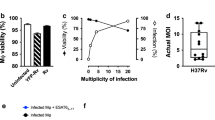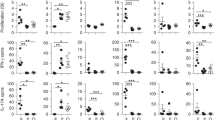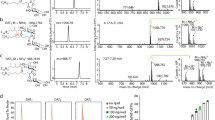Abstract
WE have Shown that peritoneal exudate macrophages, killed by heating at 56 °C for 30min, can markedly suppress the antibody response to heterologous erythrocytes in primary Mishell–Dutton cultures1. This heat treatment does not destroy the ability of the macrophages to form rosettes with sheep red blood cells (SRBCs) in the presence of cytophilic antibody, suggesting that some membrane surfaces remain undamaged. The heat treatment, however, does prevent the macrophages from excluding Trypan blue dye, indicating that the cells are no longer viable. Treatment of the macrophages at higher temperatures or with 0.1% glutaraldehyde destroys both their ability to form rosettes and to suppress Mislhell–Dutton cultures. Macrophage membranes, semppurified by separation on sucrose gradients, can act similarly—that is, suppress primary Mishell–Dutton cultures and form rosettes with SRBCs in the presence of cytophilic antibody (W.P. and R.K.G., unpublished). The heat-killed macrophages do not diminish the viability of the cell cultures even when they are maximally suppressive. We have interpreted these results to indicate that the dead macrophages suppress the immune response in culture by absorbing out, and thus rendering inoperative, some factors which are necessary for the cell interactions which result in the generation of plaque-forming cells. This contention is supported by the ability of the heat-killed macrophages to absorb out the helper activity found in the supernatants of mixed lymphocyte reactions (W.P. and R.K.G., unpublished). We reasoned that, if macrophages could absorb interaction factors, they might be able to absorb suppressive factors if they were added to a culture in which suppression was occurring and thus augment the response of suppressed but not normal cultures.
This is a preview of subscription content, access via your institution
Access options
Subscribe to this journal
Receive 51 print issues and online access
$199.00 per year
only $3.90 per issue
Buy this article
- Purchase on Springer Link
- Instant access to full article PDF
Prices may be subject to local taxes which are calculated during checkout
Similar content being viewed by others
References
Ptak, W., and Gershon, R. K., J. Immun., 155, 1346–1350 (1975).
Eardley, D. D., and Gershon, R. K., J. Immun. (in the press).
Feldmann, M., Transplant. Rev., 13, 3–34 (1972).
Author information
Authors and Affiliations
Rights and permissions
About this article
Cite this article
GERSHON, R., EARDLEY, D. & PTAK, W. Functional inactivation of suppressor T cells by heat-killed macrophages. Nature 262, 216–217 (1976). https://doi.org/10.1038/262216a0
Received:
Accepted:
Published:
Issue Date:
DOI: https://doi.org/10.1038/262216a0
This article is cited by
-
From Mysterious Supernatant Entity to miRNA-150 in Antigen-Specific Exosomes: a History of Hapten-Specific T Suppressor Factor
Archivum Immunologiae et Therapiae Experimentalis (2015)
-
Altered expression of human monocyte Fc receptors in malignant disease
Nature (1977)
Comments
By submitting a comment you agree to abide by our Terms and Community Guidelines. If you find something abusive or that does not comply with our terms or guidelines please flag it as inappropriate.



